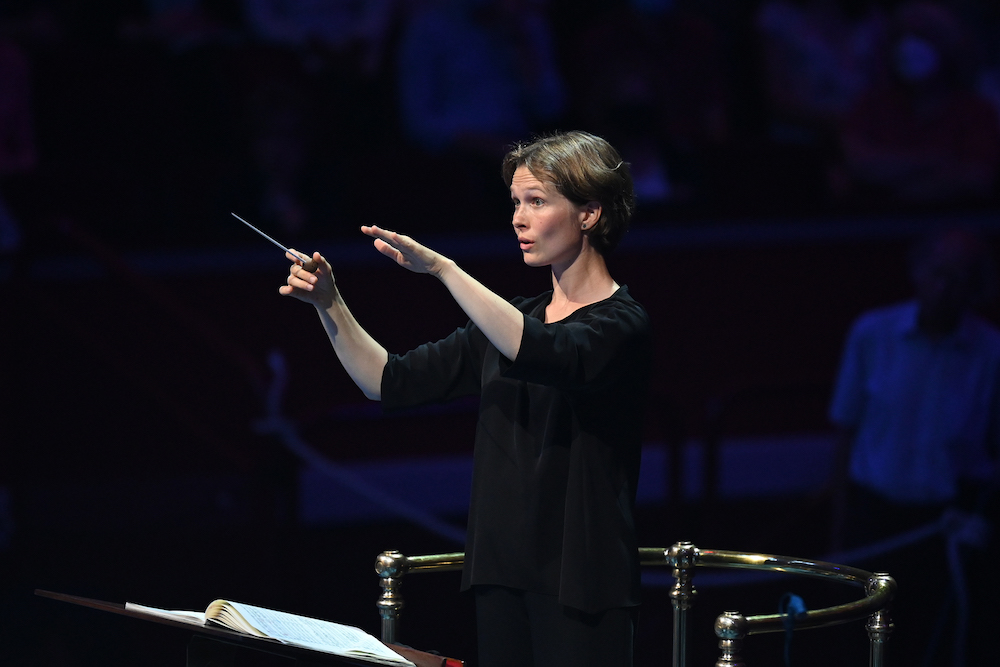
BBC Proms 5 August Ruth Gipps Symphony No.2 in B major, Thomas Adès’ The Exterminating Angel Symphony, Johannes Brahms Symphony No.3 in F major
I have been sitting it out for nine months, waiting for proper concerts with a live audience to recommence.
The BBC Proms is this year my reintroduction to concert going and there can’t be many better ways to start a new concert season than seeing Mirga Gražinyte-Tyla conduct ‘her own’ City of Birmingham Symphony Orchestra (CBSO)?
Two Proms premiere performances by British composers in one evening should have attracted a capacity audience. But perhaps the extremely wet weather dampened the spirits of some regular concert goers.
Ruth Gipps (1921-99) used to be a CBSO oboist and also performed as a solo pianist with the same orchestra. She had her first composition performed at the age of 8 and later studied with Gordon Jacob and Ralph Vaughan Williams. In her thirties a shoulder injury put an end to her career as a soloist which meant that she focused on composing.
Gipps’s Second Symphony (1945) was supposed to celebrate the end of WWII, but the composer admitted later that she had tried to depict the effect of the war on a young woman’s private life. Gipps’s own, at times traumatic, experience of the war comes to the fore in a number of passages. Ruth’s husband went off to fight and she didn’t see him until the war ended. This one-movement symphony has a fairly classic structure and Gipps makes no attempt to adhere to any modernist trends. The opening section depicts the almost carefree mood before the war, which pretty soon converges with the stark realisation that war is inevitable. The sadness creeps in with the short solo violin passage, but there is still time for a burst of hope that it will soon be over. The pastoral element that follows, with echoes of Vaughan Williams, was rendered movingly by the CBSO. The second section with its fanfare and march sees Gipps’s husband departure for the theater of war. Yes, it’s all rather theatrical, maybe even filmic. Once the soldiers have disappeared into the distance the soldier’s wife is left to reflect on a very uncertain future. The adagio with its muted tones of deep despair reminds me of Sibelius and even if I have no evidence that Gipps knew his work, her teacher Vaughan Williams was positively a fan. But the work ends in a fanfare of joy and not only does Gipps’s husband return, there is a powerful sense of hope in the final section of the work. The multi-talented Gipps was also a prolific conductor and I’m sure that this fact inspired Mirga Gražinyte-Tyla together with the CBSO to deliver a superb performance of a work that deserves more regular outings.

Thomas Adès’s opera The Exterminating Angel (2015-16) is based on Luis Buñuel‘s Mexican film (1962) with the same name. Last year Adès composed a symphony adapting some of the music from the opera as well as adding a newly composed movement . It’s interesting to note that the original film contains no music.The first movement focuses on the entrance of the guests. In the film this happens twice. In the symphony the unstable entrance of the bourgeois guests to the palatial house also receives a slightly amended reprise. The grand dinner party gets under way, but pretty soon it emerges that some mysterious compulsion stops the guests from leaving the room. As the guests become increasingly hostile towards each other and anxious, all survival tactics seem futile and the tribal nature of a society in free fall emerges. In the second movement this descent into hell is illustrated by a snare drum led ostinato reminiscent of Shostakovich’s seventh symphony (first movement). Does this relentless music represent the exterminating angel of the title? Buñuel wanted to mock the church and the pretensions of the (Mexican) upper class, but Adès struggles to convey that in the music without the words. The third movement depicts the suicide of two lovers with a fairly predictable mock (?) sentimentality. It is perhaps the fourth movement with its wonky waltzes that comes closest to reflecting Buñuel’s surrealist style. Adès’ has described the Waltzes, that can be heard in the fourth movement, as ‘joining together the bits of a broken porcelain object’. Here the off-kilter instrumental humour is used to great effect and in the vein of Buñuel’s film. There is no waltz in the film but I imagine that Adès sees the Viennese dance as a symbol of glamour and easy seduction. But Adès’s waltzes are not meant to be seductive, they are disturbing and eventually wipe the smile off your face, when you realise that the exterminating angel is already in the (Albert) hall, sitting in your seat.
The CBSO’s musicians were still forced to sit at a social distance from each other which seemed to enhance the clarity and accoustics, or perhaps it was further evidence of the magic that is Mirga’s elegant conducting style.